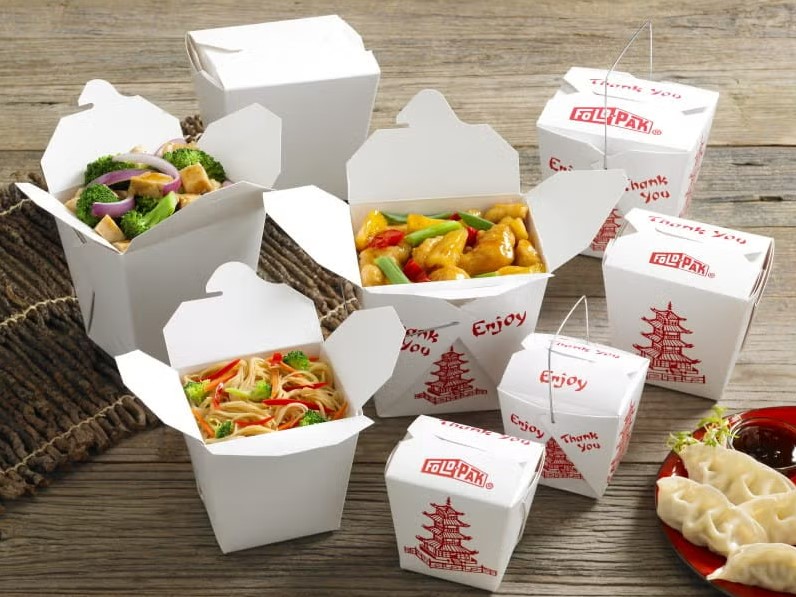The All-American Origins of the Chinese Takeout Box
The folded paper containers with wire handles that carry billions of orders of Kung Pao chicken, lo mein, and egg rolls each year actually originated right here in the United States. The quintessential Chinese takeout box was invented in Chicago in 1894 by an American named Frederick Weeks Wilcox. His ingenious origami-inspired design proved perfectly suited for transporting piping hot, savory foods. Over a century later, these disposable cartons have become ubiquitous with Chinese cuisine across America.
Wilcox devised his clever folding carton as a paper version of the wooden oyster pails commonly used in the 19th century. His lightweight paperboard container offered advantages for food delivery compared to tin or ceramic vessels. The folded construction allowed steam to escape while preventing spills and leaks.
After receiving a patent in 1894, Wilcox’s “paper pail” was first mass produced around 1900 by Bloomer Brothers to hold raw oysters. But the design seemed destined for Chinese food based on how well it preserved flavors and aromas during trips to front doors across America.
Rise of Chinese Food Deliveries
Chinese immigration to the United States surged in the 19th century, especially after the 1849 California Gold Rush. Incoming prospectors and railway workers craved familiar Cantonese dishes adapted with local ingredients like beef and broccoli. As Chinatowns blossomed in San Francisco, New York, and other hubs, Chinese restaurants catered to diverse patrons.
Following World War II, America’s taste for Chinese cuisine expanded further in tandem with suburbanization. Chinese food became a popular weekend dining and takeout option in postwar suburbs lacking ethnic fare. No longer just for special occasions, it was now welcome casual comfort food delivered to families and college students nationwide.
Wilcox’s paper pail offered the perfect vessel for transporting chop suey, egg foo young, and other saucy specialties. The containers kept ingredients from intermingling during transit while preventing spills in the takeout bag. Leftovers re-warmed nicely in the same resealable boxes. By the 1950s, Chinese restaurants were synonymous with the trapezoidal folding cartons.

An Iconic Chinese Takeout Box
In the 1970s, graphic designer Leslie Buck gave the standard oyster pail a dash of Chinese flair. Working for the folding carton company Golden Venture Group (originally the Riegel Paper Corporation), Buck added pagoda-style red lettering and the phrases “Thank You” and “Enjoy” in a Chinese-inspired font.
These decorative touches aligned with the greater cultural craze for tiki bars, egg rolls, and films like The World of Suzie Wong. Suddenly those nondescript white cartons were bursting with color and exotic appeal. The red pagoda lettering lent an auspicious touch, since red symbolizes good fortune and joy in Chinese culture.
Buck’s ornamental patterns remain unchanged decades later, gracing hundreds of millions of takeout containers churned out annually. Though invented in Chicago, these iconic boxes are mistakenly known as “Chinese takeout containers” across America. They are synonymous with kung pao cuisine, despite being an American conception.
The Perfect Chinese Food Vessel
Part of the takeout box’s appeal is its versatility. The folded construction provides a stable base to hold generous portions of noodles or fried rice without spilling. Hot steam escapes through the top, while aromas are retained to enhance the meal. The thin wire handle allows easy transport from a restaurant’s front counter to a kitchen table.
Once the initial contents have been devoured, leftovers store neatly in the same container. The hinged top flaps down to seal in remaining food without need for plastic wrap or foil. Compared to other packaging options, the paperboard is relatively eco-friendly and decomposes more readily after use.
Another advantage is the box’s ability to transform into a temporary plate. Simply lift the wire handle free from its notched tabs and remove it. The hexagonal carton can then unfurl into a flat-bottomed plate shape perfect for serving saucy dishes without extra dishware.

The portability, efficient storage, and versatility of Chinese takeout boxes add to the appeal of grabbing quick Asian bites. These clever paper vessels make it easy to savor hard-to-replicate flavors at home. No wonder billions of orders are entrusted to the trusty six-sided box each year.
An Enduring Packaging Innovation
Though he never tasted Kung Pao chicken, Frederick Wilcox would undoubtedly be amazed to see his folding paper pail repurposed globally as Chinese food cartons. His innovative packaging endures over a century later as a ubiquitous takeout box synonymous with Asian cuisine in the U.S.
Billions of servings of egg rolls, fried rice, and fortune cookies have journeyed from restaurants to satisfy customers thanks to Wilcox’s ingenious origami-inspired design. The recyclable paperboard containers keep conveying piping hot, aromatic fare to hungry patrons across America. While their contents have changed, the enduring brilliance of their packaging continues to hit the spot.



